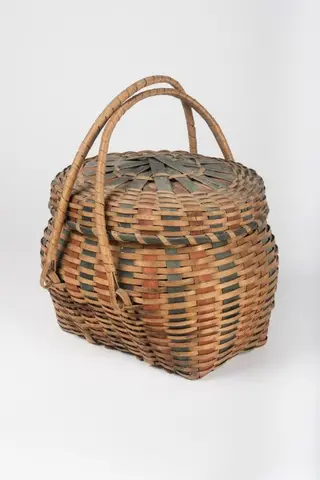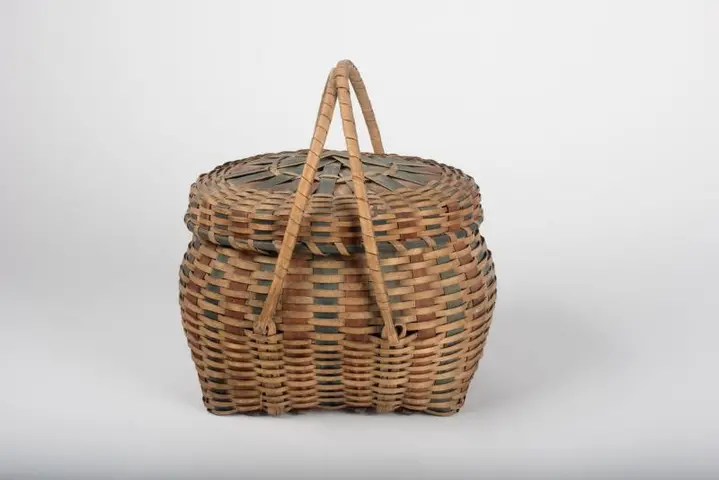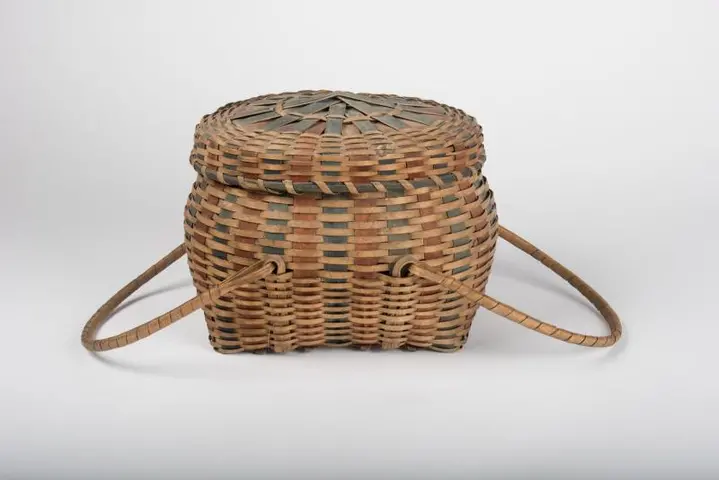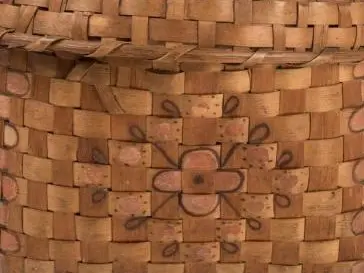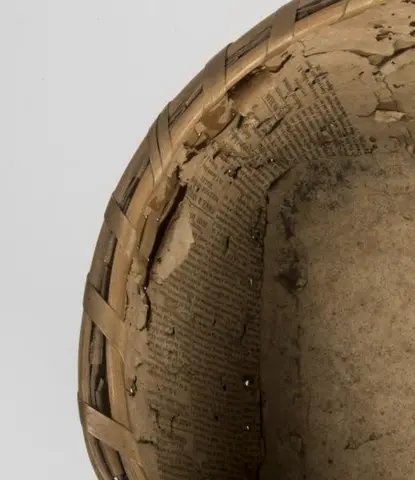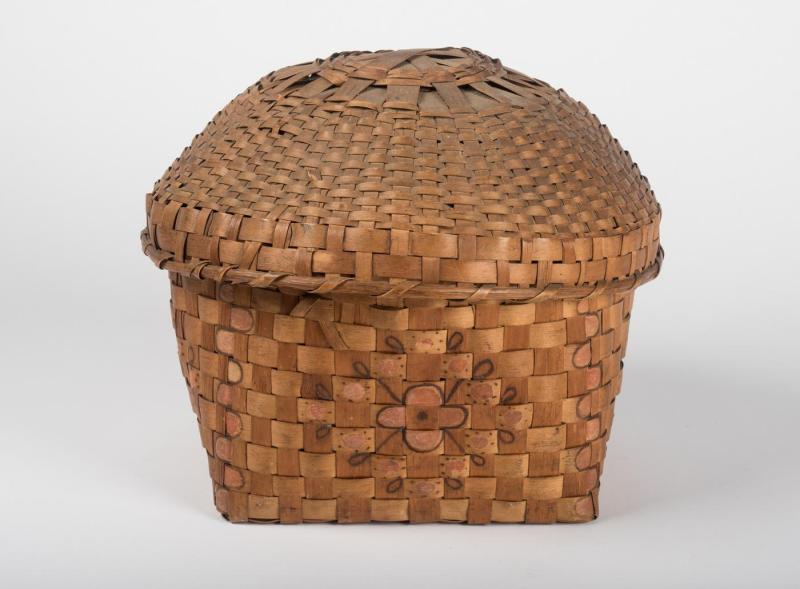Object Story: Basket - Body
Basket
Baskets are carriers of culture. Making a basket is a way to understand important cultural teachings. Basketmaking skills were, and are, passed down from generation to generation within Indigenous families. Basketmaking skills can now be learned in Indigenous community museums and cultural centers.
Ash splint baskets like this one are made by tribal groups who lived in the Northeastern woodlands region of North America for many thousands of years. Today this region includes over forty different tribal groups and at least sixty distinct languages. For Indigenous people, baskets serve many functions and purposes and historically were often decorated. There is significant variation in baskets by both region and cultural groups demonstrated in types of materials used, the form and proportion of the basket, and the decoration technique. Cultural differences can also be seen in a more detailed study of the types of production, the width of the basket materials, the construction of the rim and handles, and the primary and secondary design elements and decoration.
Basketmaking in the Northeastern region of what is now known as the United States went through many changes over time. Beginning in the seventeenth century, the arrival of white colonists to North America led to the destruction of Indigenous people and their cultures through disease, enslavement, warfare, removal from homelands, and environmental degradation, which changed traditional basketmaking and traditional ways of life. Selling baskets continues to be an important economic industry in many communities where basketmaking traditions continue to this day.
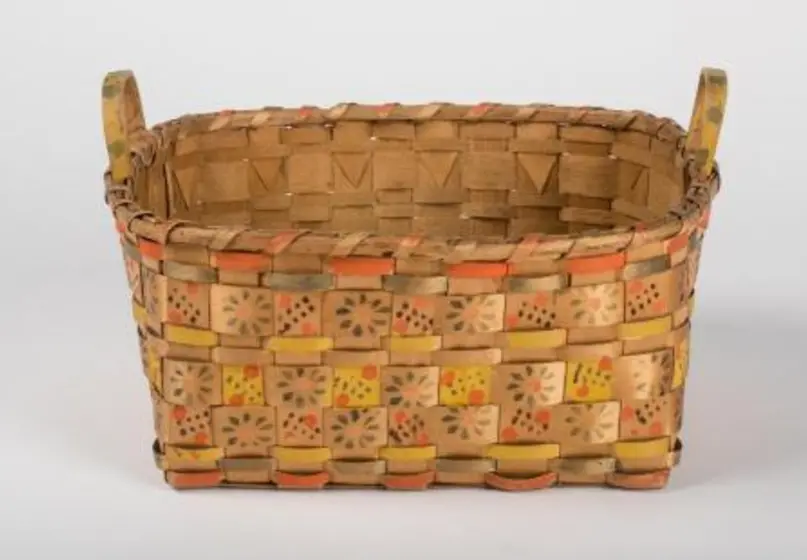
Unrecorded artist (Northeastern Native American), Splint woven basket, Maine, late 19th century, wood and pigment. Gift of Jonathan and Karin Fielding, 2016.25.24
Ash splint baskets have unique structures and design. These baskets come from parts of the country now known as Connecticut. Very few ash splint baskets were made outside of New England. The original inhabitants of the area were part of the Algonquian tribes that included at least forty-five different tribes and subtribes. The southeastern New England groups who are most well known for making baskets of this type included the Nipmuck, Mohegan, Pequot, Niantic, Narraganset, and Long Island Montauk. Other basket makers included the Penobscot, Maliseet, Pennacook, Abenaki, and members of the Haudenosaunee (Iroquois) nation. There were as many different styles of baskets and designs as there were groups making them.

Map of Indigenous Tribes in Northeast United States circa 1500 before displacement.
Native Americans used baskets for many utilitarian purposes, including holding water. Baskets were almost always decorated. Different groups used different designs, colors, and styles. This made each basket easy to distinguish among different makers and tribes. A very good basket maker could tell the differences between baskets made by artists from different places.
By the nineteenth century, many baskets were being collected by white tourists and collectors and this changed the nature of the craft. Even before this time, baskets and other artistic production like textiles were widely exchanged between Indigenous groups and differences in style, colors, and decoration gave each a distinctive association with tribal nations or communities of artists.

J. H. S. (Mohegan), Basket, ca. 1880, ash splint and dye. Gift of Jonathan and Karin Fielding, 2016.25.50
Many Indigenous crafts were community based. Groups of men or women worked in specific roles, like collecting and processing the raw materials and then weaving and decorating. Craft production was truly collective and multigenerational and was centered around communities and families, rather than as a solo artist working in a studio. Craft knowledge tended to be passed on through generations of families.
Baskets like these are made by splitting very thin strips of wood called “splints” with a special crooked knife and soaking the splints in water until they are pliable enough to weave together. In the nineteenth century, baskets would be used to hold food, clothing, tools, or other household objects.
Basket
Unrecorded artist (Northeastern Native American), Basket, New England area, ca. 1832, woven ash. Gift of Jonathan and Karin Fielding, 2016.25.25
Clues in the Making
Notice the different widths of the splints on this basket and the decorative elements. Narrow splints were not typically used in early versions of these baskets. This is an older basket and was probably made before the 1840s. The type of design and the materials of the basket help us to determine that it was made prior to widespread European influences and preferences.
Decorative Design Motifs
Mohegan and Niantic groups were known to have a strong preference for using dots for decoration. This basket has a clear design motif called a dome-shaped medallion that can be seen in the Mohegan tribal seal. This painted decoration is one of the main reasons we can likely identify it as being an Indigenous-made, southern New England basket.
Lined with Newspaper
There’s a surprise inside. This basket is lined with newspaper from the period, and this helps us date the object to circa 1832.
Very few baskets exist from the time before contact with the Europeans. As more settlers arrived, things began to change. Europeans, including the Dutch, Swedish, and English, also had their own basket-making traditions. Through trade and other interactions, the Europeans brought new tools and techniques that Indigenous groups gradually adopted to make their basket splints.
As early as 1659, Indigenous people in the area were moved off of their lands by colonists through various acts by the government of Connecticut. Once they lost the use of their lands and were forced to give up traditions, many Indigenous people fell into poverty. Indigenous people lived on the outskirts of towns on very poor land and were not able to hunt and fish as they had for hundreds of years. By the year 1850 only about 400 of the original Indigenous people remained.
While it may look like a simple basket, every basket has rich symbolism and cultural importance. Making baskets for trade was a way for Indigenous cultures to survive and maintain their traditions. In the early 1800s, the basket makers adopted the use of wooden blocks that they could use as molds to make baskets faster. They changed the baskets' color and decorations. Instead of plant dyes, they adopted commercial dyes that are brighter. Indigenous people would often make baskets with designs and decorations that were preferred by the Europeans. Sometimes baskets had traditional styles mixed with European-inspired designs.
Making baskets was traditionally a craft for women and required significant technical skill and artistry. Often women would go from town to town to sell their baskets. There was a high demand for baskets because of their utility. They could be used in all parts of the household and have been recorded in household inventories.
By the end of the nineteenth century, tourists were very interested in buying “Indian” made objects. In the late 1800s, Victorian resorts in the Northeast created markets to sell to tourist families; later mass production was facilitated by non-Indigenous middlemen. Although it almost died out at the end of the nineteenth century, basket making continues to be an important art that has survived and continues to evolve into new forms. Today, native basket making has reached new heights of creativity and innovation because it is being passed down from generation to generation. However, the trees used to make the baskets are under severe threat by an invasive insect, the emerald ash borer beetle, which has devastated forests of ash trees in New England and across North America.
Questions for Discussion
- Each basket is unique: What are the similarities and differences of these baskets? How or why might this be?
- What might have been stored in these baskets?
- Why might someone put a design on a basket? How might a functional item also be a thing of beauty?
- What are some ways you might imagine that baskets changed over time?
- How can an object like this basket show evidence of cultural survival?
